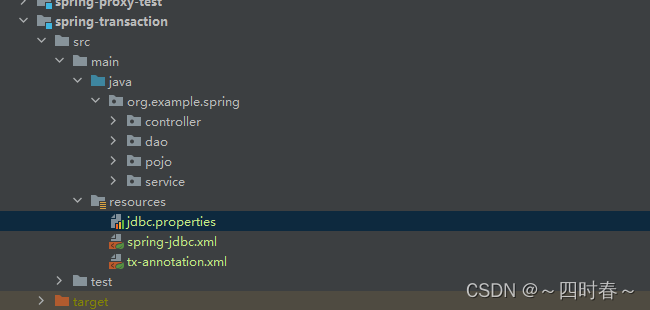Spring-声明式事务
声明式事务
- 一、简介
- 1、准备工作
- 2、测试
- 二、声明式事务概念
- 1、编程式事务
- 2、声明式事务
- 3、基于注解的声明式事务
- 1.测试无事务情况
- 2.加入事务
- ①@Transactional注解标识的位置
- ②事务属性:只读
- ③事务属性:超时
- ④事务属性:回滚策略
- ⑤事务属性:事务隔离级别
- ⑥事务属性:事务传播行为
一、简介
Spring 框架对 JDBC 进行封装,使用 JdbcTemplate 方便实现对数据库操作
1、准备工作
①加入依赖
<dependencies>
<!-- 基于Maven依赖传递性,导入spring-context依赖即可导入当前所需所有jar包 -->
<dependency>
<groupId>org.springframework</groupId>
<artifactId>spring-context</artifactId>
<version>5.3.1</version>
</dependency>
<!-- Spring 持久化层支持jar包 -->
<!-- Spring 在执行持久化层操作、与持久化层技术进行整合过程中,需要使用orm、jdbc、tx三个
jar包 -->
<!-- 导入 orm 包就可以通过 Maven 的依赖传递性把其他两个也导入 -->
<dependency>
<groupId>org.springframework</groupId>
<artifactId>spring-orm</artifactId>
<version>5.3.1</version>
</dependency>
<!-- Spring 测试相关 -->
<dependency>
<groupId>org.springframework</groupId>
<artifactId>spring-test</artifactId>
<version>5.3.1</version>
</dependency>
<!-- junit测试 -->
<dependency>
<groupId>junit</groupId>
<artifactId>junit</artifactId>
<version>4.12</version>
<scope>test</scope>
</dependency>
<!-- MySQL驱动 -->
<dependency>
<groupId>mysql</groupId>
<artifactId>mysql-connector-java</artifactId>
<version>8.0.16</version>
</dependency>
<!-- 数据源 -->
<dependency>
<groupId>com.alibaba</groupId>
<artifactId>druid</artifactId>
<version>1.0.31</version>
</dependency>
</dependencies>
②创建jdbc.properties
jdbc.driver=com.mysql.cj.jdbc.Driver
jdbc.url=jdbc:mysql://localhost:3309/ssm?serverTimezone=UTC
jdbc.username=root
jdbc.password=123456

③配置Spring的配置文件
<?xml version="1.0" encoding="UTF-8"?>
<beans xmlns="http://www.springframework.org/schema/beans"
xmlns:xsi="http://www.w3.org/2001/XMLSchema-instance"
xmlns:context="http://www.springframework.org/schema/context"
xsi:schemaLocation="http://www.springframework.org/schema/beans http://www.springframework.org/schema/beans/spring-beans.xsd http://www.springframework.org/schema/context https://www.springframework.org/schema/context/spring-context.xsd">
<!-- 引入jdbc依赖-->
<context:property-placeholder location="classpath:jdbc.properties"></context:property-placeholder>
<bean id="dataSource" class="com.alibaba.druid.pool.DruidDataSource">
<property name="driverClassName" value="${jdbc.driver}"></property>
<property name="url" value="${jdbc.url}"></property>
<property name="username" value="${jdbc.username}"></property>
<property name="password" value="${jdbc.password}"></property>
</bean>
<!-- 配置 JdbcTemplate用于test测试-->
<bean class="org.springframework.jdbc.core.JdbcTemplate">
<property name="dataSource" ref="dataSource"></property>
</bean>
</beans>
2、测试
①在测试类装配 JdbcTemplate
@RunWith(SpringJUnit4ClassRunner.class)
@ContextConfiguration("classpath:spring-jdbc.xml")
public class JDBCTemplateTest {
@Autowired
private JdbcTemplate jdbcTemplate;
}
②测试增删改功能
@Test
//测试增删改功能
public void testUpdate(){
String sql = "insert into t_emp values(null,?,?,?)";
int result = jdbcTemplate.update(sql, "张三", 23, "男");
System.out.println(result);
}
③查询一条数据为实体类对象
@Test
//查询一条数据为一个实体类对象
public void testSelectEmpById(){
String sql = "select * from t_emp where id = ?";
Emp emp = jdbcTemplate.queryForObject(sql, new BeanPropertyRowMapper<>
(Emp.class), 1);
System.out.println(emp);
}
二、声明式事务概念
1、编程式事务
事务功能的相关操作全部通过自己编写代码来实现:
Connection conn = ...;
try {
// 开启事务:关闭事务的自动提交
conn.setAutoCommit(false);
// 核心操作
// 提交事务
conn.commit();
}catch(Exception e){
// 回滚事务
conn.rollBack();
}finally{// 释放数据库连接
conn.close();
}
编程式的实现方式存在缺陷:
细节没有被屏蔽:具体操作过程中,所有细节都需要程序员自己来完成,比较繁琐。
代码复用性不高:如果没有有效抽取出来,每次实现功能都需要自己编写代码,代码就没有得到复
用。
2、声明式事务
既然事务控制的代码有规律可循,代码的结构基本是确定的,所以框架就可以将固定模式的代码抽取出来,进行相关的封装。
封装起来后,我们只需要在配置文件中进行简单的配置即可完成操作。
- 好处1:提高开发效率
- 好处2:消除了冗余的代码
- 好处3:框架会综合考虑相关领域中在实际开发环境下有可能遇到的各种问题,进行了健壮性、性
能等各个方面的优化
所以,我们可以总结下面两个概念: - 编程式:自己写代码实现功能
- 声明式:通过配置让框架实现功能
3、基于注解的声明式事务
①加入依赖
准备工作已加(同简介中的准备工作)
②创建jdbc.properties
准备工作 已加(同简介中的准备工作)
③配置Spring的配置文件
准备工作 已加(同简介中的准备工作)
④创建表
CREATE TABLE `t_book` (
`book_id` int(11) NOT NULL AUTO_INCREMENT COMMENT '主键',
`book_name` varchar(20) DEFAULT NULL COMMENT '图书名称',
`price` int(11) DEFAULT NULL COMMENT '价格',
`stock` int(10) unsigned DEFAULT NULL COMMENT '库存(无符号)',
PRIMARY KEY (`book_id`)
) ENGINE=InnoDB AUTO_INCREMENT=3 DEFAULT CHARSET=utf8;
insert into `t_book`(`book_id`,`book_name`,`price`,`stock`) values (1,'斗破苍
穹',80,100),(2,'斗罗大陆',50,100);
CREATE TABLE `t_user` (
`user_id` int(11) NOT NULL AUTO_INCREMENT COMMENT '主键',
`username` varchar(20) DEFAULT NULL COMMENT '用户名',
`balance` int(10) unsigned DEFAULT NULL COMMENT '余额(无符号)',
PRIMARY KEY (`user_id`)
) ENGINE=InnoDB AUTO_INCREMENT=2 DEFAULT CHARSET=utf8;
insert into `t_user`(`user_id`,`username`,`balance`) values (1,'admin',50);
⑤创建组件
创建BookController:
@Controller
public class BookController {
@Autowired
private BookService bookService;
public void buyBook(Integer bookId, Integer userId){
bookService.buyBook(bookId, userId);
}
}
创建接口BookService:
public interface BookService {
/**
* 买书
* @param userId
* @param bookId
*/
void buyBook(Integer userId, Integer bookId);
}
创建实现类BookServiceImpl:
@Service
public class BookServiceImpl implements BookService {
@Autowired
private BookDao bookDao;
@Override
/**
* Transactional参数含义:
* readOnly:只读
* timeout:超时时间,超过设定的时间强制回滚
*/
@Transactional(
//readOnly = true
//timeout = 3
//noRollbackFor = ArithmeticException.class
//noRollbackForClassName = "java.lang.ArithmeticException"
//isolation = Isolation.DEFAULT
propagation = Propagation.REQUIRES_NEW
)
public void buyBook(Integer userId, Integer bookId) {
//SECONDS:秒 MINUTES:分钟 DAYS:天 HOURS:小时
try {
TimeUnit.SECONDS.sleep(5);
} catch (InterruptedException e) {
e.printStackTrace();
}
//查询图书的价格
Integer price = bookDao.getPriceByBookId(bookId);
//更新图书的库存
bookDao.updateStock(bookId);
//更新用户的余额
bookDao.updateBalance(userId, price);
//System.out.println(1/0);
}
}
创建接口BookDao:
public interface BookDao {
/**
* 根据图书的id查询图书的价格
* @param bookId
* @return
*/
Integer getPriceByBookId(Integer bookId);
/**
* 更新图书的库存
* @param bookId
*/
void updateStock(Integer bookId);
/**
* 更新用户的余额
* @param userId
* @param price
*/
void updateBalance(Integer userId, Integer price);
}
创建实现类BookDaoImpl:
@Repository
public class BookDaoImpl implements BookDao {
@Autowired
private JdbcTemplate jdbcTemplate;
@Override
public Integer getPriceByBookId(Integer bookId) {
String sql = "select price from t_book where book_id = ?";
return jdbcTemplate.queryForObject(sql, Integer.class, bookId);
}
@Override
public void updateStock(Integer bookId) {
String sql = "update t_book set stock = stock - 1 where book_id = ?";
jdbcTemplate.update(sql, bookId);
}
@Override
public void updateBalance(Integer userId, Integer price) {
String sql = "update t_user set balance = balance - ? where user_id = ?";
jdbcTemplate.update(sql, price, userId);
}
}
1.测试无事务情况
@RunWith(SpringJUnit4ClassRunner.class)
@ContextConfiguration("classpath:tx-annotation.xml")
public class TxByAnnotationTest {
@Autowired
private BookController bookController;
@Test
public void testBuyBook(){
bookController.buyBook(1, 1);
//bookController.checkout(1, new Integer[]{1,2});
}
}
2.加入事务
在Spring的配置文件中添加配置:
<?xml version="1.0" encoding="UTF-8"?>
<beans xmlns="http://www.springframework.org/schema/beans"
xmlns:xsi="http://www.w3.org/2001/XMLSchema-instance"
xmlns:context="http://www.springframework.org/schema/context" xmlns:tx="http://www.springframework.org/schema/tx"
xsi:schemaLocation="http://www.springframework.org/schema/beans http://www.springframework.org/schema/beans/spring-beans.xsd http://www.springframework.org/schema/context https://www.springframework.org/schema/context/spring-context.xsd http://www.springframework.org/schema/tx http://www.springframework.org/schema/tx/spring-tx.xsd">
<!-- 扫描组件-->
<context:component-scan base-package="org.example.spring"></context:component-scan>
<!-- 导入外部组件-->
<context:property-placeholder location="classpath:jdbc.properties"></context:property-placeholder>
<!-- 配置数据库-->
<bean id="dataSource" class="com.alibaba.druid.pool.DruidDataSource">
<property name="driverClassName" value="${jdbc.driver}"></property>
<property name="url" value="${jdbc.url}"></property>
<property name="username" value="${jdbc.username}"></property>
<property name="password" value="${jdbc.password}"></property>
</bean>
<!-- 配置测试数据库的bean-->
<bean class="org.springframework.jdbc.core.JdbcTemplate">
<property name="dataSource" ref="dataSource"></property>
</bean>
<!-- 配置事务管理器-->
<bean id="transactionManager"
class="org.springframework.jdbc.datasource.DataSourceTransactionManager">
<property name="dataSource" ref="dataSource"></property>
</bean>
<!-- 开启事务注解-->
<tx:annotation-driven transaction-manager="transactionManager"></tx:annotation-driven>
</beans>
注意:导入的名称空间需要 tx 结尾的那个。

②添加事务注解
因为service层表示业务逻辑层,一个方法表示一个完成的功能,因此处理事务一般在service层处理
在BookServiceImpl的buybook()添加注解@Transactional
③观察结果
由于使用了Spring的声明式事务,更新库存和更新余额都没有执行
①@Transactional注解标识的位置
@Transactional标识在方法上,只会影响该方法
@Transactional标识的类上,会影响类中所有的方法
②事务属性:只读
①介绍
对一个查询操作来说,如果我们把它设置成只读,就能够明确告诉数据库,这个操作不涉及写操作。这
样数据库就能够针对查询操作来进行优化。
②使用方式
@Transactional(readOnly = true)
public void buyBook(Integer bookId, Integer userId) {
//查询图书的价格
Integer price = bookDao.getPriceByBookId(bookId);
//更新图书的库存
bookDao.updateStock(bookId);
//更新用户的余额
bookDao.updateBalance(userId, price);
//System.out.println(1/0);
}
③注意
对增删改操作设置只读会抛出下面异常:
Caused by: java.sql.SQLException: Connection is read-only. Queries leading to data modification
are not allowed
③事务属性:超时
①介绍
事务在执行过程中,有可能因为遇到某些问题,导致程序卡住,从而长时间占用数据库资源。而长时间占用资源,大概率是因为程序运行出现了问题(可能是Java程序或MySQL数据库或网络连接等等)。
此时这个很可能出问题的程序应该被回滚,撤销它已做的操作,事务结束,把资源让出来,让其他正常程序可以执行。
概括来说就是一句话:超时回滚,释放资源。
②使用方式
@Transactional(timeout = 3)
public void buyBook(Integer bookId, Integer userId) {
try {
TimeUnit.SECONDS.sleep(5);
} catch (InterruptedException e) {
e.printStackTrace();
}
//查询图书的价格
Integer price = bookDao.getPriceByBookId(bookId);
//更新图书的库存
bookDao.updateStock(bookId);
//更新用户的余额
bookDao.updateBalance(userId, price);
//System.out.println(1/0);
}
③观察结果
执行过程中抛出异常:
org.springframework.transaction.TransactionTimedOutException: Transaction timed out:
④事务属性:回滚策略
①介绍
声明式事务默认只针对运行时异常回滚,编译时异常不回滚。
可以通过@Transactional中相关属性设置回滚策略
- rollbackFor属性:需要设置一个Class类型的对象(回滚)
举例:
@Transactional(rollbackFor = CustomException.class)
通过将rollbackFor属性设置为CustomException.class,告诉Spring只有当CustomException异常发生时才回滚事务。
- rollbackForClassName属性:需要设置一个字符串类型的全类名(回滚)
举例:
@Service
@Transactional
public class UserService {
@Transactional(rollbackForClassName = "java.lang.RuntimeException")
public void saveUser(User user) {
// 保存用户信息的代码
throw new RuntimeException("保存用户信息失败");
}
}
rollbackForClassName属性接受一个字符串类型的异常类名。当在事务执行期间抛出与指定异常类名匹配的异常时,事务将会回滚。如果抛出的异常不匹配,则事务不会回滚。
在上面的例子中,如果saveUser()方法抛出RuntimeException异常,事务将会回滚。
需要注意的是,rollbackForClassName属性接受异常类名的字符串表示,类名需要包含完整的包路径。另外,也可以通过rollbackFor属性来指定异常类的Class对象,实现相同的效果。
- noRollbackFor属性:需要设置一个Class类型的对象(针对某个类不回滚)
- noRollbackForClassName属性:需要设置一个字符串类型的全类名
⑤事务属性:事务隔离级别
①介绍
数据库系统必须具有隔离并发运行各个事务的能力,使它们不会相互影响,避免各种并发问题。一个事务与其他事务隔离的程度称为隔离级别。SQL标准中规定了多种事务隔离级别,不同隔离级别对应不同的干扰程度,隔离级别越高,数据一致性就越好,但并发性越弱。
隔离级别一共有四种:
- 读未提交:READ UNCOMMITTED
允许Transaction01读取Transaction02未提交的修改。 - 读已提交:READ COMMITTED、
要求Transaction01只能读取Transaction02已提交的修改。 - 可重复读:REPEATABLE READ
确保Transaction01可以多次从一个字段中读取到相同的值,即Transaction01执行期间禁止其它事务对这个字段进行更新。 - 串行化:SERIALIZABLE
确保Transaction01可以多次从一个表中读取到相同的行,在Transaction01执行期间,禁止其它事务对这个表进行添加、更新、删除操作。可以避免任何并发问题,但性能十分低下。
各个隔离级别解决并发问题的能力见下表:
| 隔离级别 | 脏读 | 不可重复读 | 幻读 |
|---|---|---|---|
| READ UNCOMMITTED | 有 | 有 | 有 |
| READ COMMITTED | 无 | 有 | 有 |
| REPEATABLE READ | 无 | 无 | 有 |
| SERIALIZABLE | 无 | 无 | 无 |
| ②使用方式 |
@Transactional(isolation = Isolation.DEFAULT)//使用数据库默认的隔离级别
@Transactional(isolation = Isolation.READ_UNCOMMITTED)//读未提交
@Transactional(isolation = Isolation.READ_COMMITTED)//读已提交
@Transactional(isolation = Isolation.REPEATABLE_READ)//可重复读
@Transactional(isolation = Isolation.SERIALIZABLE)//串行化
⑥事务属性:事务传播行为
①介绍
当事务方法被另一个事务方法调用时,必须指定事务应该如何传播。例如:方法可能继续在现有事务中
运行,也可能开启一个新事务,并在自己的事务中运行。
②测试
创建接口CheckoutService:
public interface CheckoutService {
void checkout(Integer[] bookIds, Integer userId);
}
创建实现类CheckoutServiceImpl:
@Service
public class CheckoutServiceImpl implements CheckoutService {
@Autowired
private BookService bookService;
@Override
@Transactional
//一次购买多本图书
public void checkout(Integer[] bookIds, Integer userId) {
for (Integer bookId : bookIds) {
bookService.buyBook(bookId, userId);
}
}
}
在BookController中添加方法:
@Autowired
private CheckoutService checkoutService;
public void checkout(Integer[] bookIds, Integer userId){
checkoutService.checkout(bookIds, userId);
}
在数据库中将用户的余额修改为100元
③观察结果
可以通过@Transactional中的propagation属性设置事务传播行为
修改BookServiceImpl中buyBook()上,注解@Transactional的propagation属性
@Transactional(propagation = Propagation.REQUIRED),默认情况,表示如果当前线程上有已经开
启的事务可用,那么就在这个事务中运行。经过观察,购买图书的方法buyBook()在checkout()中被调
用,checkout()上有事务注解,因此在此事务中执行。所购买的两本图书的价格为80和50,而用户的余额为100,因此在购买第二本图书时余额不足失败,导致整个checkout()回滚,即只要有一本书买不
了,就都买不了。
@Transactional(propagation = Propagation.REQUIRES_NEW),表示不管当前线程上是否有已经开启的事务,都要开启新事务。同样的场景,每次购买图书都是在buyBook()的事务中执行,因此第一本图书购买成功,事务结束,第二本图书购买失败,只在第二次的buyBook()中回滚,购买第一本图书不受影响,即能买几本就买几本。
